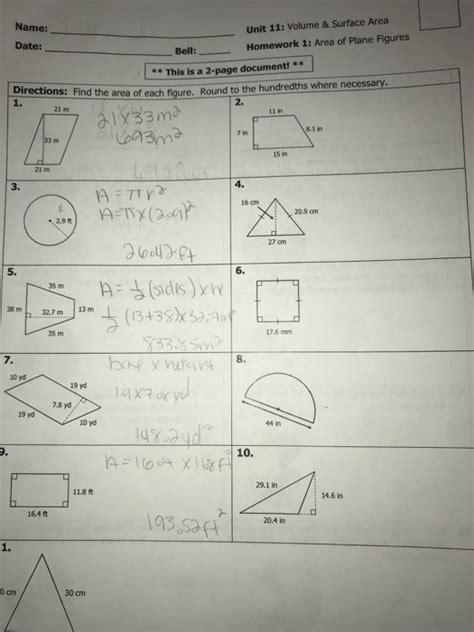Understanding volume and surface area is essential for various applications across industries. From architecture and construction to engineering and manufacturing, these concepts play a crucial role in calculations, design, and optimization.

Volume
Volume measures the amount of three-dimensional space occupied by an object. It is the amount of liquid or gas that an object can hold or displace. Volume is expressed in cubic units, such as cubic meters (m³), cubic centimeters (cm³), or liters (L).
Applications
- Calculating storage capacities of containers
- Determining the size of buildings and other structures
- Estimating the volume of excavation projects
- Measuring the fluid capacity of tanks and reservoirs
Surface Area
Surface area measures the total area of the surfaces of an object. It is a two-dimensional measure of the object’s exterior. Surface area is expressed in square units, such as square meters (m²), square centimeters (cm²), or square inches (in²).
Applications
- Calculating the amount of paint or other coatings needed
- Estimating heat transfer efficiency
- Determining the surface area of sails for wind propulsion
- Measuring the skin surface area for medical applications
Volumes and Surface Areas of Common Shapes
The table below shows the formulas for calculating the volume and surface area of common shapes:
| Shape | Volume (V) | Surface Area (A) |
|---|---|---|
| Cube | V = s³ | A = 6s² |
| Rectangular Prism | V = lwh | A = 2(lw + lh + wh) |
| Cylinder | V = πr²h | A = 2πr(h + r) |
| Cone | V = (1/3)πr²h | A = πr(r + √(h² + r²)) |
| Sphere | V = (4/3)πr³ | A = 4πr² |
Applications in Various Fields
Architecture and Construction
- Calculating the volume of a building to estimate construction costs
- Determining the surface area of walls and ceilings for painting or wallpapering
- Optimizing the use of space in floor plans
Engineering and Manufacturing
- Measuring the volume of tanks and containers for storage and fluid handling
- Estimating the surface area of heat exchangers for efficient heat transfer
- Analyzing the surface area of automotive components for aerodynamic considerations
Medicine
- Calculating the volume of blood loss during surgery
- Estimating the surface area of wounds for healing purposes
- Measuring the skin surface area for drug absorption and radiation therapy
Strategies for Optimizing Volume and Surface Area
- Maximize volume for storage: Design containers with large volumes for maximum storage capacity.
- Minimize surface area for insulation: Reduce the surface area of heat-insulating structures to minimize heat transfer.
- Increase surface area for heat exchange: Design heat exchangers with large surface areas to enhance heat transfer efficiency.
- Optimize surface area for coatings: Calculate the surface area of objects to accurately estimate the amount of paint or other coatings needed.
Innovative Applications
Nanotechnology
Nanomaterials with high surface area-to-volume ratios exhibit enhanced properties and novel applications, such as in catalysis and drug delivery.
Medical Imaging
Surface area measurements play a crucial role in medical imaging techniques like computed tomography (CT) and magnetic resonance imaging (MRI).
Materials Science
Tailoring the volume and surface area of materials enables the development of advanced properties and applications, such as in lightweight composites and functionalized surfaces.
Sustainable Design
Optimizing the volume and surface area of buildings and products can contribute to energy efficiency and waste reduction.
Customer Needs and Wants
- Accurate volume and surface area calculations for various applications
- Efficient storage and handling of materials and fluids
- Optimal heat transfer and energy conservation
- Accurate material quantities for construction and manufacturing
- Innovative materials with enhanced properties due to controlled volume and surface area
Step-by-Step Approach to Volume and Surface Area Calculations
- Identify the shape of the object.
- Measure the relevant dimensions (length, width, height, radius).
- Apply the appropriate formula for the volume and surface area of the shape.
- Convert the units to the desired format (e.g., m³ to L).
- Verify the results for accuracy.
